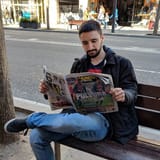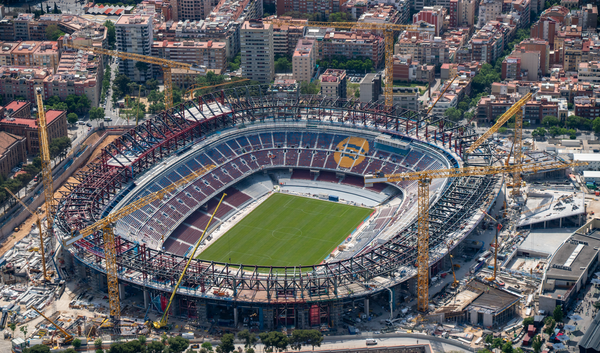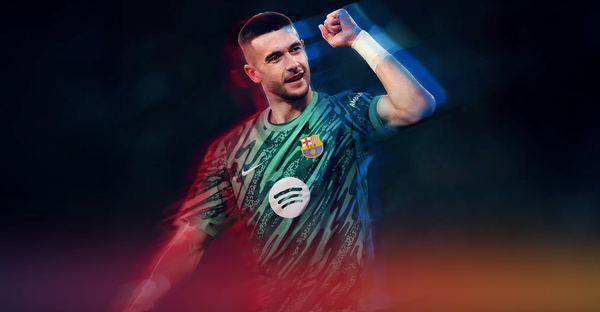Vitor Roque: In-depth tactical analysis of his roles at Xavi's Barcelona
As a talented but extremely young and inexperienced player Roque will struggle for consistent game time, but he can make it count
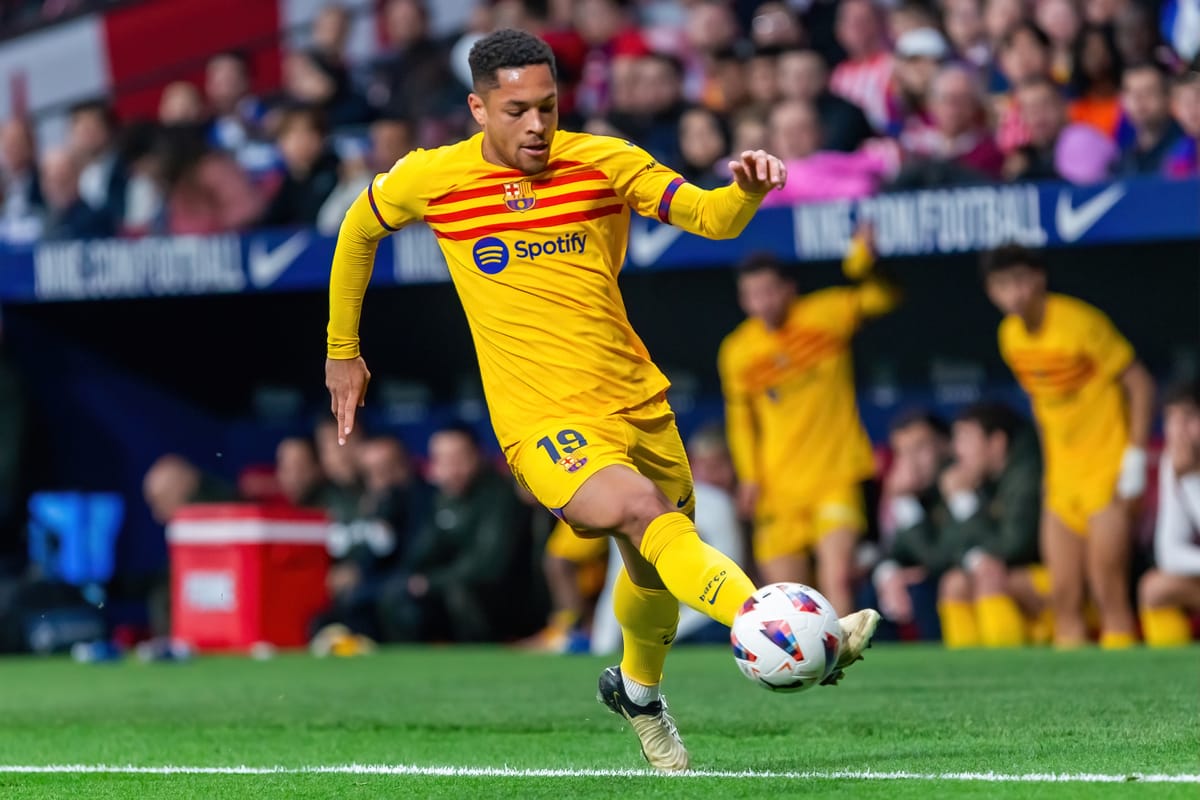
Even at 18 years old, Vitor Roque is a player who needs little introduction. The Brazilian forward has signed for Barcelona and is highly regarded as their present and future. Likened to superstars like Carlos Tevez and Sergio Aguero, and following in the footsteps of Luis Suarez and now Robert Lewandowski, Roque has big shoes to fill but also heaps of talent to make that a plausible scenario.
But how does he fit into Xavi’s Barcelona? Is he coming as Lewandowski’s current relief and future replacement? Or are there other ways the coach might put the 18-year-old to (good) use?
Let’s dive straight in.
Vitor Roque, body & mental profile
Standing at 172cm and weighing approximately 76kg, Roque’s physique is stocky and compact. He has a very developed lower body, boasting strong and wide thighs and overall short legs while his upper body is similarly physically impressive with broad shoulders and a strong chest. This type of physique and torso-to-leg length ratio (and low centre of gravity) means he can decelerate easier and use stutter steps in 1v1 scenarios.
Similarly, the build also allows for a much shorter backlift, aiding both his passing and shooting, as well as enabling explosive speed from a standstill position. Other physical traits involve incredible pace both over short (burst) and long distances (sprint), agility (aided by his low centre of gravity) and stamina.

Mental faculties include a hard-working personality but highly aggressive on-the-pitch tendencies; likened to a terrier (tenacious, feisty, strong bite, independent, determined, courageous). Roque runs a lot and covers a lot of ground when and if necessary, both good signs. Even though he’s very mobile and dynamic, he is also positionally disciplined within the limits of his role.
His lifestyle, commitment, discipline and off-the-pitch tendencies will determine how far he can go but ultimately, has the physical and mental foundation for great success.
Player profile
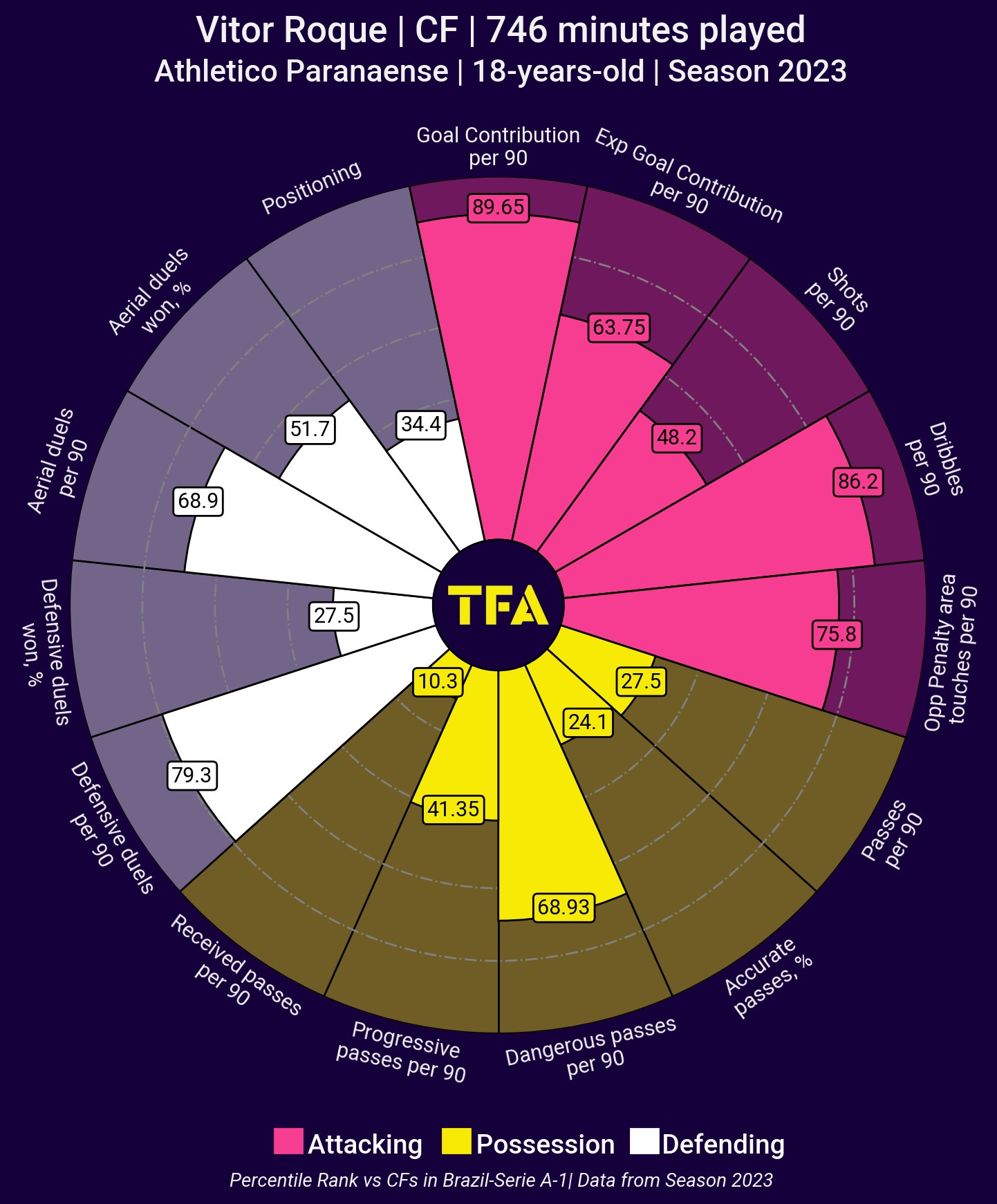
Roque is currently mostly deployed as a centre-forward, either in a single or a double striker system, ranging from a 4-2-3-1 to a 5-3-2 formation. He is mobile and dynamic, often dropping deeper, roaming and showing a right half-space bias when communicating with the middle third of the pitch. Despite being a number 9, the 18-year-old can also be deployed on the flanks as well as a secondary striker in a tandem.
Looking at the pizza chart above (kindly provided by TotalFootballAnalysis as usual), we can see Roque thrives in a low-volume, high-threat system; he’s a striker who doesn’t get much contact with the ball but makes it count in the final third and especially in the opposition’s box. He’s the type of player who likes to exploit space, run at the opposition (with and without the ball) and is a constant threat in and around the penalty area.
Roque’s movement is excellent, as is the sense of positioning, both his and his markers’. With a low centre of gravity and incredible speed, the Brazilian’s dynamic and rapid motion brings chaos and disbalance into the opposition’s defensive structure. He can be used as a pin, a back-to-goal tool, a carrier or a space invader in numerous different roles.
In addition to an excellent sense of positioning and awareness, Roque also has an elite ball striking with both feet, hitting through the ball cleanly with power and precision, deadly from close and long distances. Once he finds an angle in and around the box, he doesn't hesitate. He can finish with both feet but shows clear (and sometimes extreme) right-foot bias.
The premise
Much has been said about Roque the player but not nearly enough about how and what needs to happen for him to successfully transition to European football or more specifically, to Barcelona. There is no denying his talent; Roque is a player capable of greatness. But nothing, even his excellent physical and mental predispositions, guarantees success.
There are several points of interest that might determine the result of his new Catalan crusade. These include but are not limited to:
- Technical level in tight spaces
- Possession-heavy game vs pure transitional system
- (In)Ability to slow down the game when needed
- Potential outside of the centre-forward role
This analysis will delve deeper into these points and project Roque’s journey and immediate next steps. As these four topics are inherently connected, we’ll divide them into two main subjects: adapting to Barcelona’s style and potential outside of the centre-forward role.
Adapting to Barcelona’s style
→ Possession-heavy system
Going from South American to European football is difficult enough. But going from a non-European style to Barcelona of all clubs could prove a mountain too big for most. Roque is a player of immense quality; a player around whom you can build your future. However, to expect him to slot into the squad and the tactics seamlessly would be foolish. It’s possible, of course, but even if the tactical aspect is smooth, we have to consider the cultural difference, mentality, language, social constructs and more when determining Roque’s potential success (or failure).
That said, looking solely at his profile as a player, both his strengths and weaknesses, there are some glaring aspects we need to address. Firstly, Roque is a product of a much more vertical, rapid and freer football; Athletico Paranaense are not Barcelona, nor do they pretend to be. In fact, the young forward will have to quickly adapt to a much different style of play. The first big change is the possession game. Despite being at fault for being overly vertical, Xavi’s Barcelona still finished the 2022/23 season with an average of 62.48% possession across all competitions.
Needless to say, it’s a stark contrast when compared to Athletico Paranaense’s 47.77% in 2023. Even by Xavi’s sometimes skewed standards, Barça are far more methodical, positional and much less heavy metal. Roque himself ranks poorly when compared to other Serie A strikers in received passes, finishing in the bottom 10.3% of all centre-forwards in the league. Similarly, he ranks in the 27.5th percentile for passes played per 90, meaning his volume is very low and so is his overall on-the-ball involvement. Even Lewandowski, whose effectiveness of play in deeper areas has diminished greatly in 2022/23, almost cracks the top 10 centre-forwards in LaLiga for received passes per 90 if we only filter by the main position. Roque, by contrast, is not even in the top 60 in Serie A when using the same parameters. Quite clearly, there’s a huge gap here he’ll need to bridge.

Above, we can see Roque’s pass map for the entirety of his 2023 season. The first thing that stands out is the volume (or lack thereof). The Brazilian is not an astute passer nor a volume one; his pass map consists of simple lay-offs, albeit to either side of the pitch, with an occasional medium-to-long through ball or a pass into space.
Similarly, he’s not a conventional creator or a progressor. The brunt of both his creation and progression stems from carries; Roque will drop deep to collect the ball and then run into space with it. Take-ons/dribbles, drawing fouls in dangerous areas and shots that generate other shots are his main tools for threat, not creative or innovative passing. In fact, for a player who spends time in the middle third by design, Roque deploys very few passes into the final third and the box.
A similar thing can be said for his touches across the pitch: the higher he is, the more involved he gets. Fortunately, looking at the Barcelona centre-forward role, not significantly more is expected from Lewandowski either.
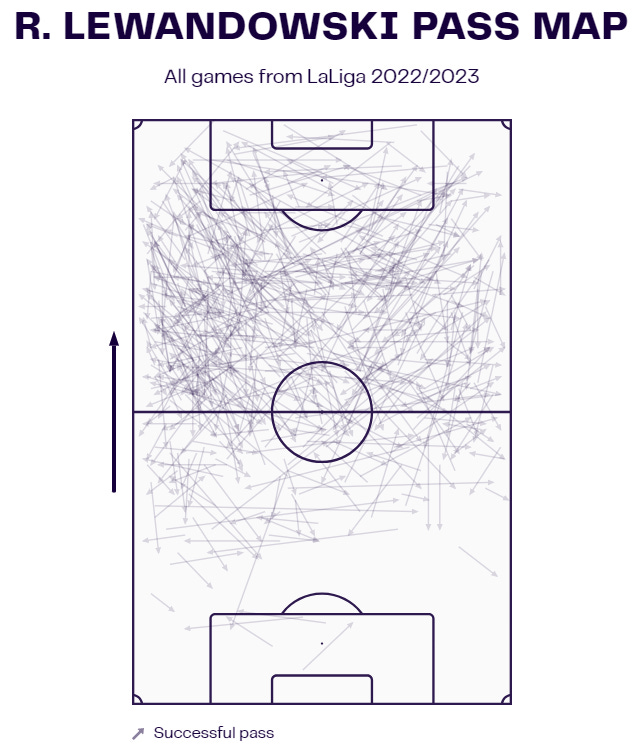
Yes, the volume is much higher and Lewandowski is much more involved on a match basis, using lay-offs for both the left and the right, something Roque is used to doing too. But more importantly, nothing Lewandowski has done when linking up with the middle third or the wide areas is completely out of Roque’s reach. In fact, the roles are quite similar in lay-offs and link-ups, only the sheer volume (and at times, pass length) is different.
That being said, however, Lewandowski was highly criticised for his lacking build-up and link-up contributions so if Roque was to replace him or add something different, he would have to improve upon the Pole’s contribution all whilst maintaining his prolific goal-scoring tally too. A daunting task for an 18-year-old kid playing in Europe - and Barcelona - for the first time.
Subscribed
A big part of how well he performs that role, however, lies in his tempo regulation and ability in tight spaces. At Athletico, Roque was practically a pure transition monster; he had ample space to exploit and all the tools to do it at the highest level. At Barcelona, facing low blocks with very little space to speak of is the more likely scenario as the Catalans and Xavi (hopefully) get more proficient at pinning the opposition back.
Of course, tempo regulation is not exclusively a centre-forward’s job, far from it, but a centre-forward needs to know when to slow down and when to speed up. At the moment, Roque only has high gears and a very aggressive approach. An argument could be made for such a profile thriving in a (comparatively) highly vertical system Xavi deploys but that doesn't negate the need for proficiency in tempo regulation. Especially since that same trait will be important in other areas too.
→ Ability in tight spaces
The ability to thrive in tight spaces is predominantly associated with midfielders; between-the-lines creators, regulators or progressors who need to shoulder the heavy pressure and keep the team’s machine ticking. But forwards, too, especially in modern times, find themselves in tight spaces. There is an argument to be made for the return of traditional strikers - or the fact they’ve never fully disappeared either - but modern football has forced the role to evolve. A lot.
This is glaringly visible in possession-based sides such as Barcelona themselves; the striker is the link, a gate, towards the open space and the box. He connects the thirds, lays the ball off and, yes, even operates in tight spaces. So how do we determine one’s ability to proficiently do this?
Technical quality is the obvious aspect: how well can a player control the ball? How aware is he of his surroundings? How well does he move and (re)position himself? But also, how well does he control his body? All of that needs to be considered.
Roque’s technical level is good but not exceptional. He’s a good dribbler, albeit not a smooth one, but often effective in the right circumstances. With the low centre of gravity, he can shift his body and evade tackles at the last moment or at the very least draw fouls in favourable positions. His first touch ranges from good to sloppy/fake-clumsy (same for dribbling) but there are issues here.
Firstly, Roque doesn’t scan nearly enough considering his back-to-goal tendencies and proclivity for half-turns. This can lead to dispossessions and unnecessary turns into traffic. While a ‘hunched’ posture (pictured below) allows him to hold the ball up back to goal and 'hide' it when trying to make a separation for a shot, it also immediately limits the central play potential he can have due to a) Limited vision/awareness (both due to the lack of scanning and downward-looking posture) and b) No optimal angles for pass execution (body not in the position to effectively and accurately release the ball).
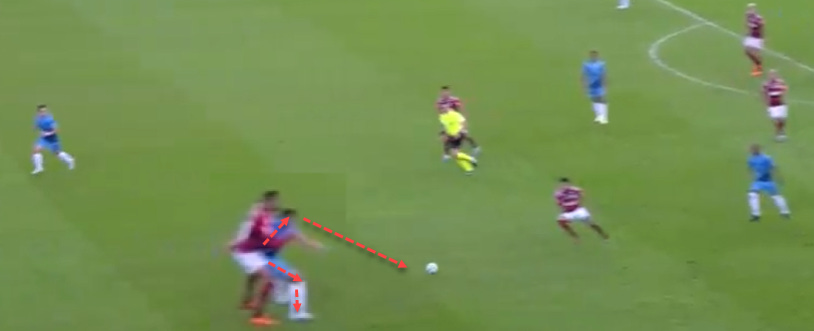
Secondly, his right-foot bias severely limits him in tight spaces. Roque is touted as an ambipedal player and while that holds (somewhat) true for his finishing, everywhere else it’s clear he prefers his right foot, even excessively so. The bias limits his reception, evasion and especially dribbling from right to left because the ball has to go across his body if he starts the dribble with his right going inside when facing the goalmouth. The same is true when going outside in back-to-goal scenarios on the left and going inside in back-goal-scenarios on the right. Ultimately, it gives the marker more time to tackle and makes Roque more predictable. Interestingly, Roque will roll the ball across his body with his right foot even when it’s not necessary for him to do so, e.g. in 1v1 situations with goalkeepers or with space to his right to dribble into. To top things off, the right-foot preference is also clearly visible in his carrying and passing.
The next aspect we have to consider in the mastery of tight spaces is body control, namely stride length and step variance. Both are great indicators of one’s ability to thrive in confined areas and could also determine how well Roque handles this new environment he’s bound to find himself in. Long strides are useful in tight spaces because they allow for firmer planting of feet on the ground. When feet are firmly on the ground, it ensures the player is ready to ride the contact and shield the ball. This has on-the-ball advantages too as it provides for better ball contacts as well, allowing sounder execution of a variety of passes. For strikers especially, long strides before taking a shot can help plant the feet properly, adjust the weight, control the backlift and optimise the delivery.
When it comes to step variance, alternating between short and long steps is crucial for ball manipulation and control in tight spaces because the need for split-second decisions is higher so versatility of touch needs to be optimised to be ready for any situation. Of course, these two are connected; stride length has a direct relationship with step count. Shorter stride length means more steps. And vice versa. Step variance is just alternating between different types of steps (longer vs shorter), depending on external factors such as positioning of the ball, the opposition, teammates, intention etc.
Back to Roque, he does seem to vary steps but generally in two main situations: approaching 1v1s and attacking space off the ball. The former can be seen below.
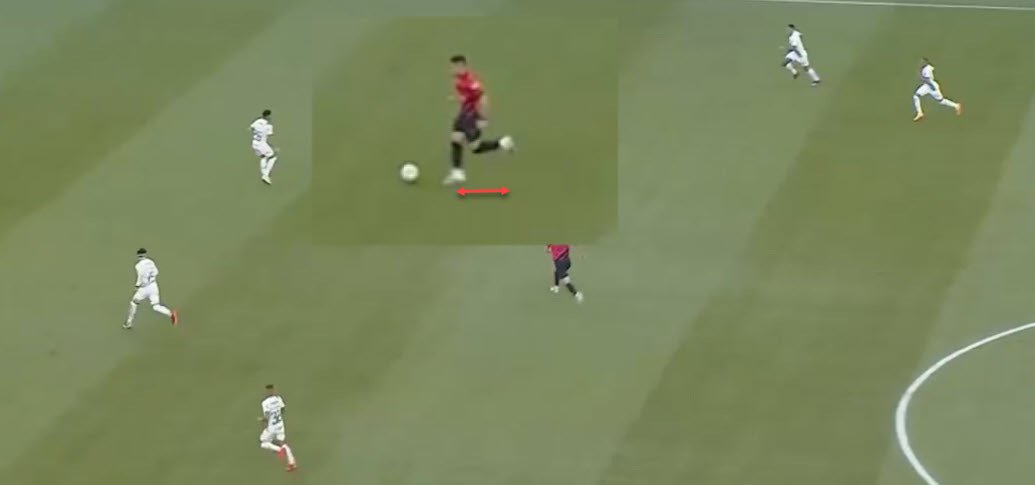

Roque prefers to run in bursts of small strides, taking a lot of steps with the ball, especially when approaching 1v1s out wide, as seen above. He waits for the marker to engage and then changes direction quickly. This is something great wingers and dribblers do and when executed properly, it’s a technique that’s very difficult to stop.
His stride changes when he attacks space without the ball. In such scenarios, Roque will prolong the stride, decrease the step count and make more powerful and rapid runs, as seen below.
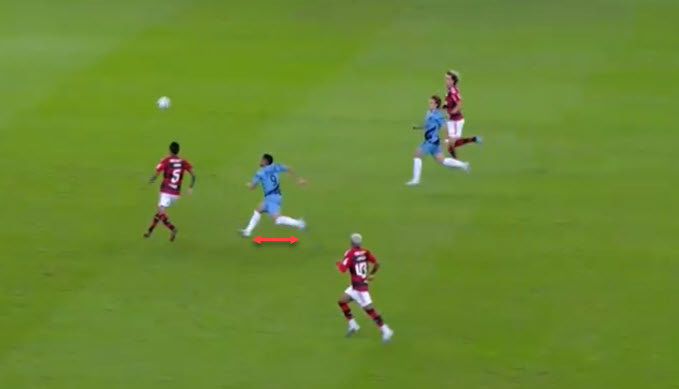
As mentioned earlier, longer strides enable him to ride contacts better and the Brazilian uses his arms well to shrug off defenders when needed. Similarly, when sprinting, he uses a lot of arm drive, keeping them behind the torso and just above or level with the waist for optimal balance and speed. All of this makes him an incredible asset in open spaces but still poses questions about his tight areas efficiency.
Currently, with an inconsistent first touch, lack of scanning, hunched positions when receiving with a heavy right-foot bias, Roque could struggle when tightly marked between the lines. Another thing to consider here is his calmness under pressure or lack thereof. The Brazilian is explosive in tight spaces when he can turn effectively and immediately put his ball-striking to use. However, he also needs to release the ball quicker, know when (not) to drive/dribble and reassess before jumping to decisions under pressure.
A lot of it can come with experience and age but in his current form, he might struggle as a combinatory - and subsequently tightly-marked - 9 at Barcelona.
Fortunately, however, there is a solution to this problem: The left wing.
Potential outside of the centre-forward role
When profiling Roque, it became quite obvious that he is an attacker of space, a constant goal-scoring threat, and an aggressive dynamo who thrives in large areas but also wants to be as close to the box as possible. And yes, most of that applies to his interpretation of the number 9 role but at Barcelona, he wouldn’t get nearly as much commodity as he did in Brazil.
Some of the flaws or tendencies in his profile suggest he may even struggle to hit the ground running as the Catalans’ immediate Lewandowski replacement/substitute. Of course, no one in their right mind would argue that Roque at 18 years of age is ready to permanently take up the mantle. However, his skill set can be used in an inverted/false winger role on the left.
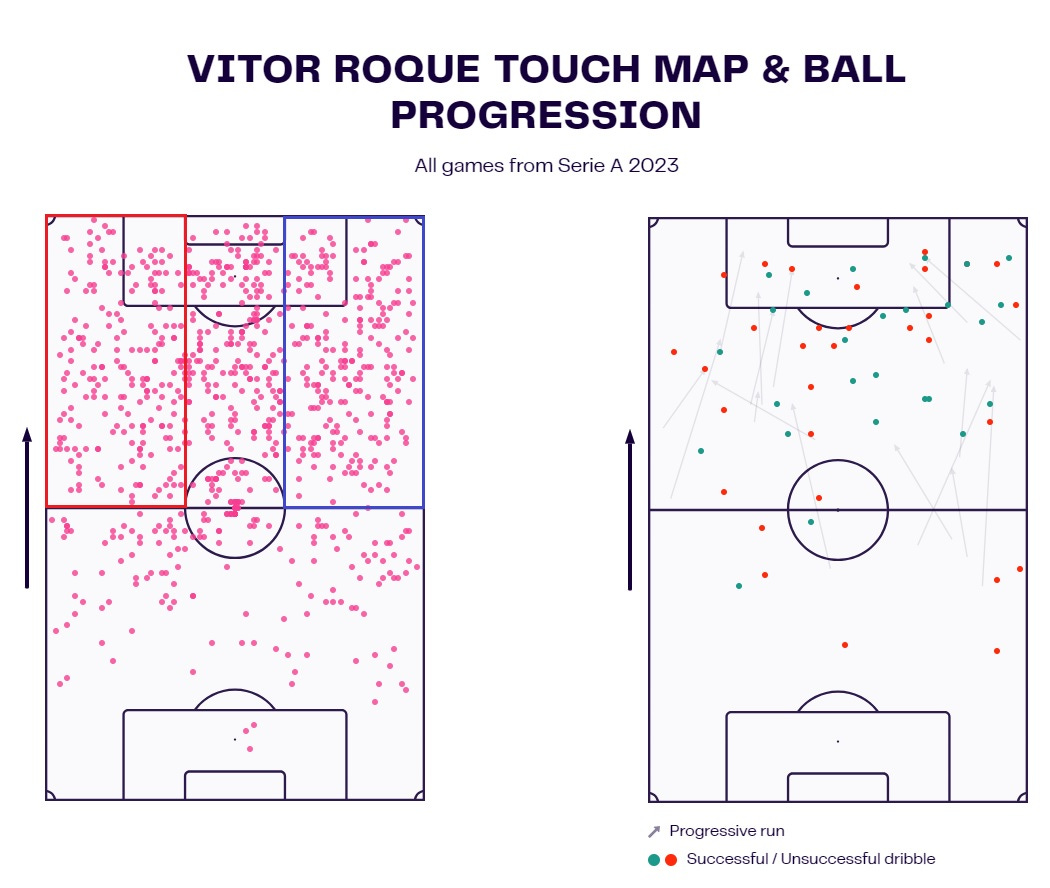
The Brazilian tends to drop to either half-spaces but prefers the right slightly more, which we can see from the graphs above. Still, the difference is in how he operates on the flanks: on the right, he spends far more time high and wide while on the left, he’s mainly crashing the box and occupying the half-space. This is significant for our analysis but there’s also a clear reason for it: his right-foot bias.
Roque’s heavy right-foot preference can push him too wide when dribbling/carrying while facing the goal on the right side. Even though he often rolls the ball across his body, when he’s in his full stride, driving with the ball forward, which he often does from the deep, his natural inclination is to follow the right foot. That inevitably takes him wide onto the flanks if he starts closer to the right side of the pitch. Sadly, as he’s not much of a creative passer (despite occasionally threading good balls), this limits his utility as a wide presence on the right. Not to mention it would potentially clash with someone like Ousmane Dembele at Barcelona.
Another limitation stemming from the right side of the pitch is his shooting technique. Roque is proficient at finishing with both left and right but this is more related to poaching from close range than it is to finishing from distance. When he cuts from the right side to the left, his angles for a right-footed shot are suboptimal. In such scenarios, Roque starts taking excessive touches and overcomplicates things, actively looking to create an angle for a right-footed attempt. This means it’s difficult to take the shot unless there’s a clear avenue to do so.
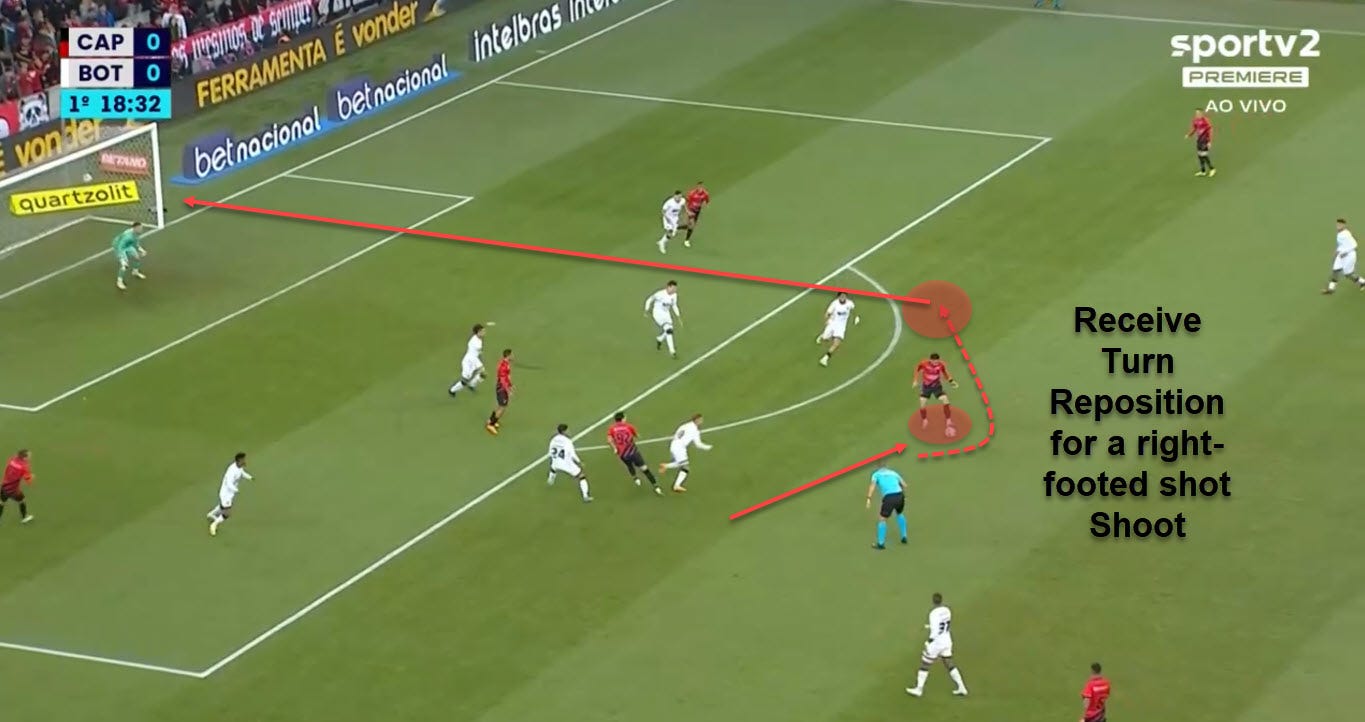
The example above doesn’t show him cutting in from right to left but still demonstrates his preference for a right-footed shot. An argument can be made for Roque recognising the space on the right and wanting to exploit it but there was time for a first-time shot with his left before the opposition finally collapse to block it. Still, he opts against it.
All of this leads us to believe the inverted RW - or a width-holding RW for that matter - is a non-factor. Even if that wasn’t the case, with the likes of Dembele and Raphinha blocking the way, it would be too difficult for Roque to push past them in the pecking order. The LW, however, is a completely different story.
Starting wide(r) on the left and then inverting/crashing the box from the left like Ansu Fati or Ferran Torres would mean he’s got a goal-scoring role and can act as an outlet for diagonals from right to left, which is a common pattern at Barcelona. The Catalans often play with an advanced left-back and a tucked-in/more conservative right-back, which fits this structure. Of course, this is assuming this remains to be the case in the upcoming season too, which, judging by their reported targets and currently available profiles, is likely to be the case.
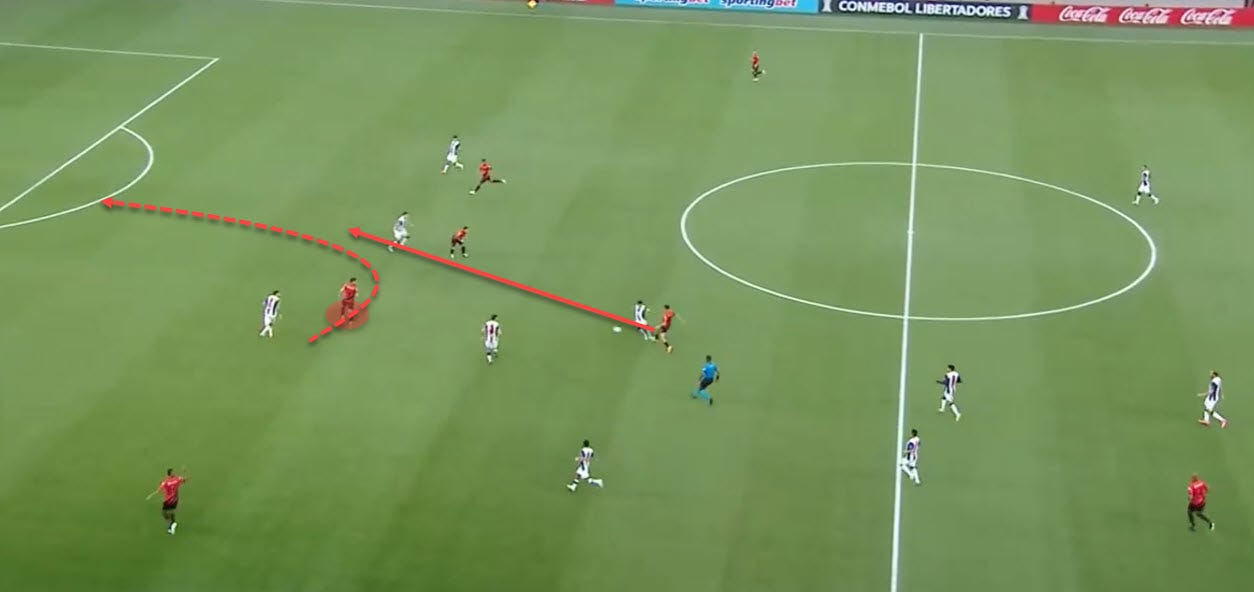
The example above shows us an instance of Roque attacking space/acting as an outlet from the left half-space and ultimately scoring a goal. This is the essence of the role, too: Roque isn’t a creative presence nor would he be one on the left. Instead, assuming Fati’s or Ferran’s role, he’d be a pure goal-scoring threat, space invader and a profile that can initially hold width before inevitably crashing the box. While his profile is certainly suited for a central striker, he fits almost perfectly into the mould of a non-creator player Xavi wants for his left side of the pitch.
Usually, at Athletico, he would arrive into the left half-space more often than starting there but both are an option at Barcelona too. Below is an example of how that can be useful for the Catalans.
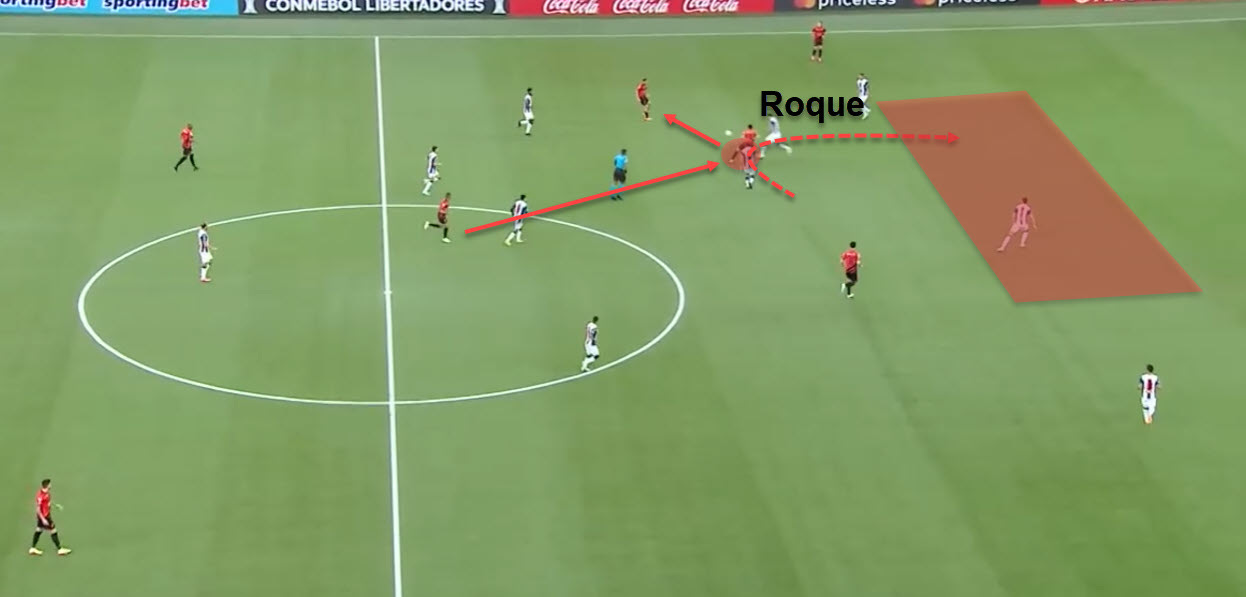
Here we see him arrive into the half-space, play a quick lay-off pass and then burst into the space behind the opposition’s backline. This sort of presence is exactly what Barcelona are missing as Gavi is unable and doesn’t fit such a role. Fati and Ferran do but neither has been performing to the best of their abilities so far. Roque is technical enough to execute these straightforward link-ups and also incredibly explosive when he can turn into space, making him nigh-unstoppable in such scenarios.
Similarly, he can act as a width-holder (rather arriving there than starting) who inverts when attacking the box from left to right; he’s decent in 1v1 scenarios when there’s space to exploit so there’s potential to be the isolated option on the left while the right is overloaded (as opposed to Barcelona often doing the opposite with Dembele isolated on the right). Roque’s physical attributes such as raw strength and pace coupled with good ‘small step’ technique and low centre of gravity mean even though he’s not a smooth dribbler, he can be an effective one, especially in open spaces out wide.
In 1v1 scenarios, he often relies on pure speed, kicking the ball beyond the defender and then simply reaching it before he does. Using body feints, Roque also often creates just enough separation to make the difference in a duel, initially moving one way before inevitably changing directions. Either way, coming in from the left side opens the angles for him much better. We saw that he actively tries to open his body for a right-footed shot even in situations where that wouldn’t be optimal so putting him in a position where that comes naturally could benefit him.
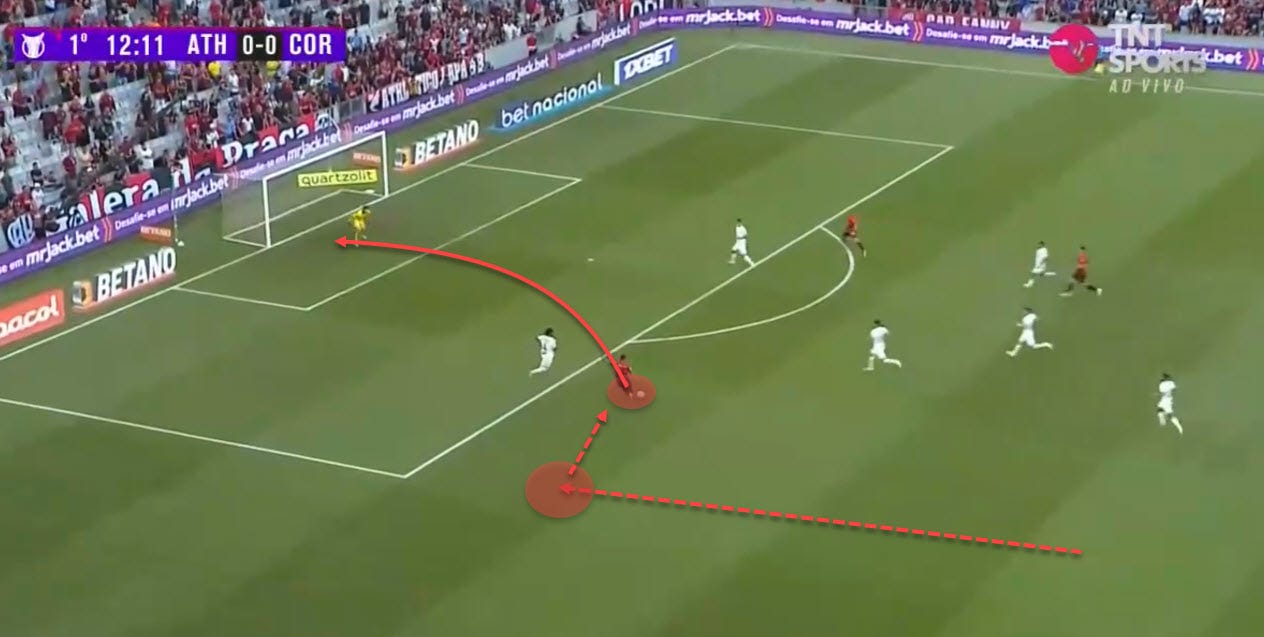
Not to mention that this setup isn’t completely uncharted territory for the young Brazilian. Even though he prefers the right side of the pitch and is usually a central presence altogether, Roque has played on the left on occasion as well. His goal-scoring prowess paired with explosive speed and the ability to combine in the half-spaces makes him an excellent pick for a very thin area of Barcelona’s squad.
We know Roque is far from a technical giant but he can do the simple things and is positionally very disciplined, meaning Xavi can count on him to stick to his role and maintain the structure.
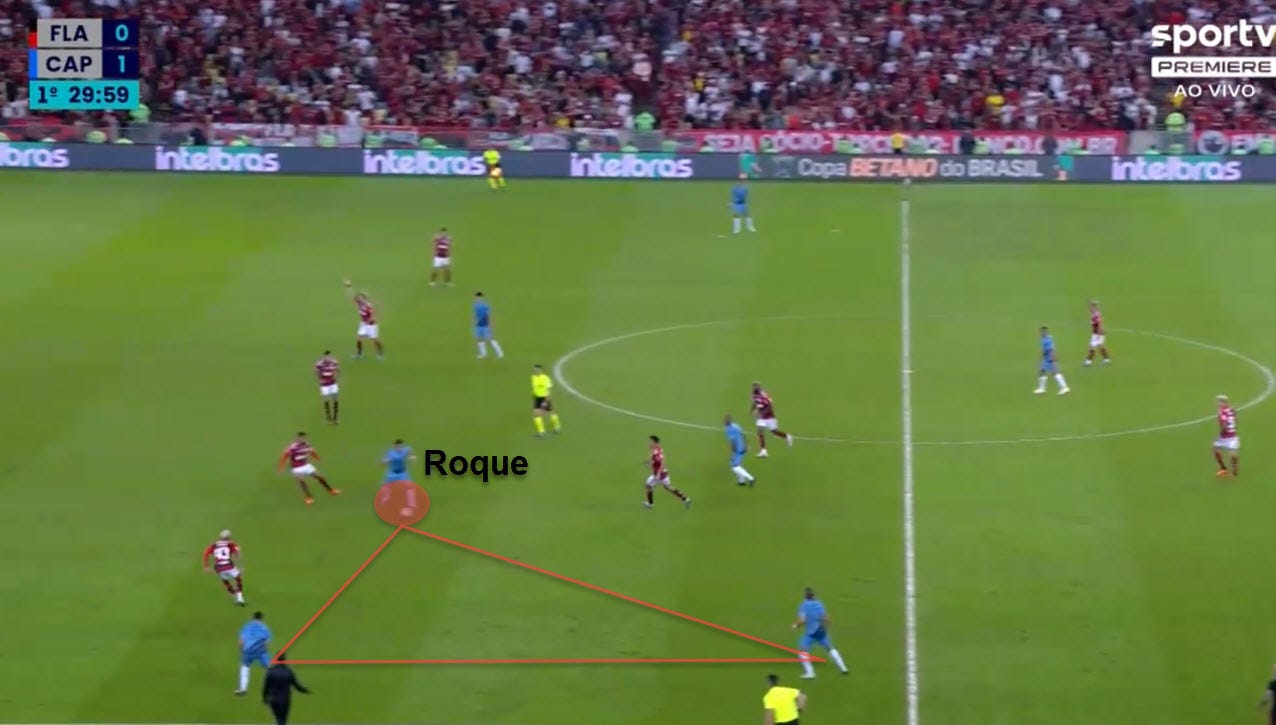
There are, however, a couple of caveats to this otherwise fitting match. The first of which relates to Xavi’s box midfield. So far, he’s been using Gavi in the false winger role, instructing the young Spaniard to invert and create the box with the other three midfielders. However, with the arrival of Ilkay Gundogan, it’s far more plausible that Barcelona will have a midfield box from the start, without the need for the winger to invert. Besides, Roque wouldn’t be used in such a way anyway.
But this poses a different question: Would Roque’s false winger role clash with the left 8 (likely Pedri) in the box midfield? Unless the winger is the one completing the left side of the box, that role should be more of a natural, width-holding LW because, in a setup with four midfielders and a winger, the full-back (Balde) gets sacrificed. In case the winger is a false one/inverted, as Roque would be, the focus also switches from positional play to quick passes fired into the feet of said wingers so they can turn, face play and generate advantages on the carry, something the Brazilian can do really well. Naturally, Barcelona’s positional play would suffer and instead, we’d see a far more straightforward system with rapid between-the-lines combinations akin to Liverpool’s.
In that scenario, 8s/10s (Pedri and Gundogan), would have to be more involved in the build-up and would have deeper starting positions; they would arrive into their half-space once the ball is already firmly into the opponent's half rather than starting and receiving there. But that, again, has a domino effect: would such a structure clash with a carrier from deep like Frenkie de Jong? Pedri and De Jong would potentially be occupying the same area in an attempt for the former to accommodate Roque. There is, however, potential to drop Frenkie even deeper into an LCB role, something akin to his Ajax days.
But that scenario applies to Roque in a highly involved half-space role, which he shouldn’t get. Instead, he would hold width in the first phase and then attack space either through curved runs or after a quick lay-off. His presence in the half-space would not be permanent or prolonged for that matter. But still, a 3-box-3 setup like that one would mean Balde would be benched as Barcelona would essentially play without full-backs. At this point in time, that is unlikely or rather, suboptimal.
However, in a more traditional 4-3-3 system, or even a 4-4-2 or a 4-2-3-1, Roque would be an excellent replacement for someone like Fati or Ferran, should they continue underperforming, without the need to sacrifice the left-back.
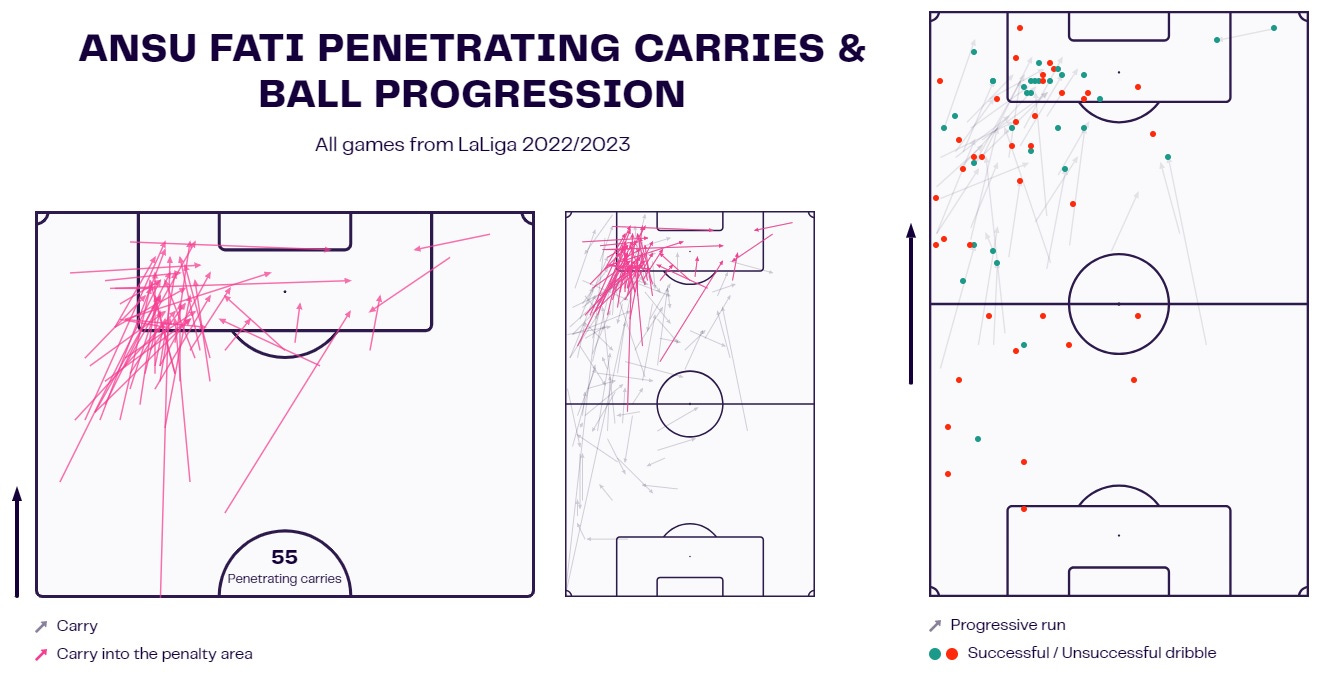
Overall, the role is comparatively light on the passing volume and more geared towards an attacker of space, carrier into the penalty area, crashing the box, and goalscoring presence on the left as opposed to a creator. So low-volume of touches but a big scoring-threat type of role. In other words, suitable for Roque.
Final remarks
As a highly talented but extremely young and inexperienced player from abroad, Roque may initially struggle for consistent game time. His quality, however, is undeniable; on the face of it, he has almost everything in his arsenal to succeed and then some. But making it at Barcelona is far from easy.
Still, the addition of Roque gives Xavi more options to consider; whether that’s a hungry youngster to give Lewandowski some rest or a slightly different approach, going back to the roots with a 4-3-3 and Roque in the Fati role.
Either way, it will be interesting to see how the young Brazilian adapts to the greatest challenge of his career so far.
